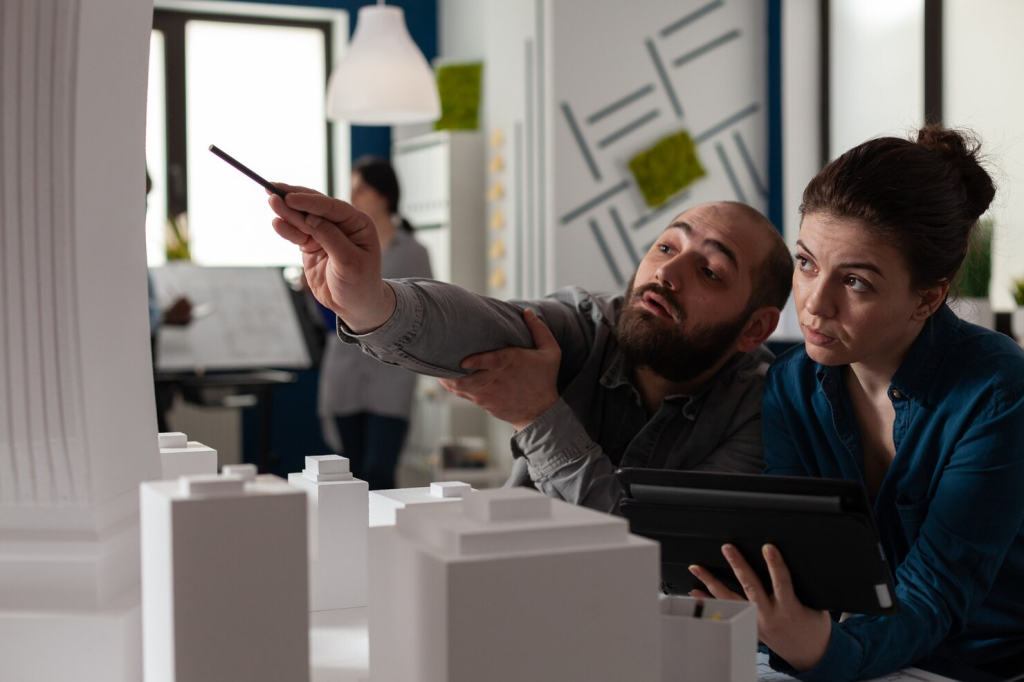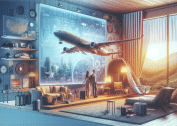In 2025, real estate design is undergoing a transformative shift, driven by sustainability, technology, and evolving lifestyle demands. These innovative approaches are redefining how spaces are conceived, built, and experienced, blending functionality with environmental responsibility and user-centric design. Drawing on insights from recent trends, this article explores cutting-edge strategies in real estate design, offering practical steps to implement them in today’s dynamic market.

Why Innovative Real Estate Design Matters in 2025
Innovative design addresses modern challenges like climate change, urbanization, and hybrid work while meeting buyer demands for sustainability, flexibility, and technology. In 2025, advancements in AI, IoT, and eco-friendly materials enable architects and developers to create spaces that are efficient, adaptable, and appealing. These designs not only enhance property value but also align with the priorities of tech-savvy, environmentally conscious consumers.
Key Innovative Approaches to Real Estate Design
Here are the leading approaches shaping real estate design in 2025, with practical applications:
1. Sustainable and Green Building Design
Eco-friendly designs prioritize energy efficiency and low environmental impact, commanding premium value.
- How It Works: Use low-carbon materials (e.g., mass timber, recycled plastic) and energy-efficient systems like solar panels or triple-glazed windows.
- Real-Life Impact: Alloy Development’s all-electric skyscraper in Brooklyn uses induction stoves and community solar, reducing emissions and utility costs.
- Benefit: Sustainable buildings attract eco-conscious buyers and meet regulatory standards like New York’s Local Law 97.
- Tip: Incorporate green certifications (e.g., LEED, ENERGY STAR) to boost marketability.
2. Smart Home and IoT Integration
Smart technologies enhance convenience, security, and efficiency through connected devices.
- How It Works: Integrate IoT devices like smart thermostats (Nest), lighting (Philips Hue), or security systems, controlled via apps or AI assistants like Grok 3.
- Real-Life Impact: A homeowner uses a smart home hub to automate lighting and HVAC, cutting energy costs by 20%.
- Benefit: Smart homes appeal to buyers seeking modern, tech-driven living.
- Tip: Use floor plan apps like CubiCasa to visualize smart device layouts for better user experience.
3. Adaptive Reuse and Retrofitting
Converting existing buildings for new uses maximizes value and sustainability.
- How It Works: Transform old offices into residential units, retail into healthcare, or warehouses into mixed-use spaces, incorporating local identity and modern design.
- Real-Life Impact: Gensler’s 2025 forecast highlights conversions like office-to-senior living, revitalizing urban spaces.
- Benefit: Retrofitting reduces construction waste and meets demand for affordable housing.
- Tip: Partner with architects using Building Information Modeling (BIM) to streamline collaborative retrofits.
4. Mixed-Use and Community-Centric Developments
Blending residential, commercial, and recreational spaces creates vibrant, walkable communities.
- How It Works: Design developments with retail, offices, and homes, plus amenities like parks or co-working spaces, as seen in Two Trees’ Domino Sugar Refinery project.
- Real-Life Impact: Seattle’s Corvidae co-op uses shared backyards for affordable housing, fostering community.
- Benefit: Mixed-use spaces reduce commutes and enhance lifestyle appeal.
- Tip: Incorporate communal areas like gardens or plazas to boost social connection.
5. Virtual and Augmented Reality (VR/AR) Design
VR/AR technologies enable immersive design visualization and client engagement.
- How It Works: Use VR for virtual property tours or AR apps like IKEA Place to visualize furnishings, enhancing buyer decision-making.
- Real-Life Impact: A buyer uses AR to test furniture layouts remotely, reducing purchase hesitancy.
- Benefit: Immersive tools save time and attract remote or international buyers.
- Tip: Integrate VR/AR with AI-powered floor plan apps for accurate, interactive designs.
Practical Strategies to Implement Innovative Design
Here’s how to apply these approaches in real estate projects:
1. Prioritize Sustainability in Design
Choose eco-friendly materials and systems to align with 2025’s green demand.
- How to Do It: Use mass timber (e.g., Neutral’s Baker’s Place) or recycled materials (e.g., Azure Printed Homes’ plastic-based construction).
- Why It Helps: Sustainable designs attract premium buyers and comply with regulations.
- Tip: Research local incentives for green building via platforms like the USDA Energy Grants database.
2. Integrate Smart Technology
Embed IoT and AI to create responsive, user-friendly spaces.
- How to Do It: Install smart home systems and use AI tools like ChatGPT to generate compelling property descriptions or layouts.
- Why It Helps: Tech-enhanced homes meet buyer expectations for convenience and efficiency.
- Tip: Start with affordable IoT devices like smart plugs to test integration.
3. Explore Adaptive Reuse Opportunities
Repurpose underutilized buildings to meet market needs.
- How to Do It: Identify vacant offices or retail spaces for conversion, using BIM for efficient planning, as seen in Gensler’s retrofit projects.
- Why It Helps: Retrofitting reduces costs and addresses housing shortages.
- Tip: Partner with local zoning experts to navigate regulations for conversions.
4. Design for Community and Flexibility
Create spaces that foster connection and adaptability.
- How to Do It: Plan mixed-use developments with amenities like co-working spaces or communal gardens, inspired by JLL’s “street to seat” approach.
- Why It Helps: Community-focused designs attract buyers seeking lifestyle and convenience.
- Tip: Use movable walls or open floor plans for adaptable living spaces.
5. Leverage VR/AR for Client Engagement
Use immersive technologies to enhance design and marketing.
- How to Do It: Offer VR tours via platforms like Matterport or AR visualization through apps like CubiCasa for 3D floor plans.
- Why It Helps: VR/AR streamlines buyer decisions and expands market reach.
- Tip: Test one VR/AR tool monthly to refine client presentations.
6. Review Designs Quarterly
Spend 20–30 minutes each quarter evaluating design performance and market alignment.
- How to Do It: Assess project sustainability, tech integration, or buyer feedback, adjusting plans based on trends like those in JLL’s 2025 report.
- Why It Helps: Regular reviews ensure designs remain innovative and competitive.
- Tip: Use tools like Notion to track design outcomes and client responses.
Sample Routine for Innovative Real Estate Design
Here’s a routine to integrate these approaches into your design process:
- Daily:
- Morning (5 minutes): Check industry updates on platforms like ArchDaily for design inspiration.
- Evening (5 minutes): Log ideas for sustainable or tech-driven features.
- Weekly:
- Sunday (15 minutes): Research one innovative design tool or material, like mass timber or VR apps.
- Monthly:
- First Sunday (20 minutes): Review project progress, focusing on sustainability or tech integration.
- Quarterly:
- First Sunday (30 minutes): Evaluate designs against market trends and plan new features.
Overcoming Common Design Challenges
- Challenge: High costs of sustainable materials.
Solution: Start with cost-effective options like recycled materials or apply for green building grants. - Challenge: Resistance to new technologies.
Solution: Offer training or pilot smart home features to demonstrate value. - Challenge: Regulatory hurdles for retrofitting.
Solution: Collaborate with zoning experts or use BIM to ensure compliance.
Tools to Support Innovative Real Estate Design
- Design and Visualization: CubiCasa (floor plans), Matterport (VR tours), Figma (prototyping).
- Smart Home: Nest (thermostats), Philips Hue (lighting), Rachio (irrigation).
- Sustainability: LEED certification tools, USDA Energy Grants database.
- Collaboration: BIM software (e.g., Revit), Notion for project tracking.
- Market Insights: ArchDaily, X communities for design trends.
The Bigger Picture: Real Estate Design in 2025
In 2025, innovative real estate design blends sustainability, technology, and community focus to meet modern demands. From all-electric skyscrapers to VR-enhanced tours, these approaches create spaces that are functional, eco-conscious, and adaptable. By embracing these trends, developers and architects can shape the future of living, aligning with the values of a tech-savvy, sustainability-driven market.
Conclusion: Shape the Future with Innovative Design
Innovative real estate design in 2025 leverages sustainability, smart technology, and community-centric approaches to create thriving spaces. Integrate green materials, IoT, and VR/AR, reviewing designs quarterly to stay competitive. Start today, and redefine real estate with forward-thinking, user-focused design.
References:
Gensler. (2025). Design Forecast 2025. https://www.creanalyst.com/gensler-design-forecast-2025/
CubiCasa. (2025). 10 Innovations That Will Change Real Estate Industry in 2025. https://www.cubi.casa/10-innovations-real-estate-2025/
Fast Company. (2025). The Most Innovative Urban Development and Real Estate Companies for 2025. https://www.fastcompany.com/most-innovative-companies-2025/
OpenPlot. (2025). Changing Landscape of Real Estate in 2025: Innovations & Trends. https://blog.openplot.com/real-estate-2025-innovations/
JLL. (2025). Outlook on Design Trends 2025. https://www.jll.com/design-trends-2025/









